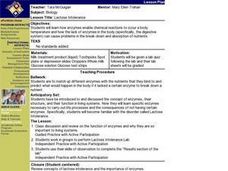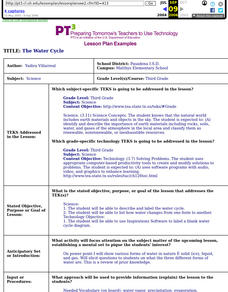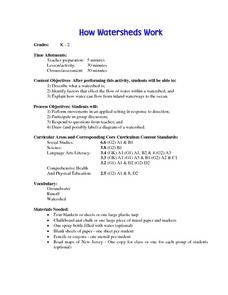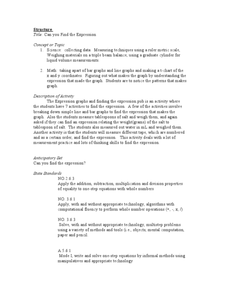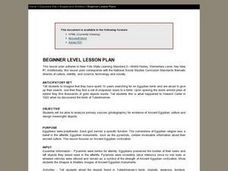Curated OER
Lactose Intolerance
Students are taught how enzymes enable chemical reactions to occur a body temperature and how the lack of enzymes in the body can cause problems in the break-down and absorpion of nutrients. They match up different enzymes with the...
Curated OER
What Colors Are Your Skittles?
Young scholars record the numbers of each color in their own Skittles. They compare their results with their partner. Students create a spreadsheet to chart the different colors found in a package of Skittles. They create a PowerPoint...
Curated OER
Sand, Sand, Everywhere Sand
Students study the physical characteristics of four types of desert regions. In this desert regions instructional activity, students watch a video about deserts and discuss the deserts. Students compare the deserts and research the ways...
Channel Islands Film
Lone Woman of San Nicolas Island: Lesson Plan 4
Imagine being stranded all alone on an island for 18 years. How would you survive? Class members are challenged to makes necessities out of natural materials that would likely be found on an island.
Curated OER
Ink Analysis and Thin Layer Chromatography
Students explain the process of TLC. They identify at least three components of ink. They analyze data and make conclusions based on laboratory observations.
Curated OER
The Water Cycle--Using Inspiration Software
Third graders describe and label the water cycle, and list how water changes from one form to another; students use Inspiration Software to label a blank water cycle diagram.
Curated OER
Fingerprinting
Students list and describe the three types of fingerprint patterns. They list and describe three layers of fingerprints that can be made. They explain why we leave fingerprints.
Curated OER
Water Cycle (Grades 2-4)
Students demonstrate their understanding of the water cycle and how it effects the environment by graphically depicting and describing the water cycle.
Curated OER
How Wathersheds Work
Students describe a watershed. They identify factors that effect the flow of water within a watershed. They explain how water can flow from inland waterways to the ocean.
Curated OER
Germs: Learning Not to Share
Students have cinnamon sprinkled onto their hands and walk around the room touching objects within their reach. Students observe all of the objects containing cinnamon fingerprints to visualize where and how germs are spread.
Aquarium of the Pacific
Turn a Cow into a Whale
Third graders explore animals that might have a common ancestor and resemble one another. For this cow and whale lesson, 3rd graders recognize the similarities between the whale and the cow. Students complete worksheets based...
Curated OER
Stopping Global Climate Change
Students synthesize or express concepts towards solving the question posed at each lab station about climate change. After all lab teams have finished, the teacher facilitates a class discussion on teams' responses to each station.
Curated OER
Endangered Species
Students define extinction, name four animals and two plant species that are extinct, list three reasons why animals and plants become extinct, and create ways that would help prevent extinction.
Curated OER
Structure and Function of Bulbs, Corms and Rhizomes
Students explore the concept of philanthropy and why people give. They investigate the importance of the tulip to Holland and the tradition of giving flowers away. They begin to explore the life cycle of tulips and dissect a bulb to...
Curated OER
Temperature (Celsius)
Third graders solve Celsius and Fahrenheit conversion problems, watch weather forecast and convert temperatures to Celsius, and design and present their own weather forecasts for different regions based on information gathered from...
Curated OER
Mendel and Heredity
Students identify the investigator whose studies formed the basis of modern genetics (Mendel). They list characteristics that make the garden pea a good study organism, and summarize the 3 major steps of Mendel¿¿¿s experiment.
Curated OER
Classification, Keys, and Phylogenetci Trees
Learners analyze relationships about animals and create a model of classifications based on both the similarities and the differences. They also discuss a dichotomous key before they create a cladograph using different types of candy.
Curated OER
Miracles of the Heart
Students watch a movie. In this cultures lesson, students read A World Without Black People and then discuss segregation. Students watch the video Partners of the Heart or Something the Lord Made and then reflect on the video in their...
Curated OER
Climate Change Challenge: Earth Day
Students explore the concept of philanthropy. In this environmental stewardship lesson plan, students watch a video about state policies pertaining to greenhouse gas emissions. Students plan and carry out an Earth Day service project...
Curated OER
Note Taking
Second graders work in groups to gather information from a factual paragraph on the topic of ants. They demonstrate taking notes by selecting 3 or 4 important key words in each sentence and write it on a note card to compile summary...
Curated OER
Can you Find the Expression
Students collect data from measurements and weights for this experiment. In this algebra lesson, students analyze graphs they create form their data to find the expression representing the data. They label which graph provided the best...
Curated OER
Shapes and Shelters
Students are be able to analyze primary sources (photographs) for evidence of Ancient Egyptian culture and design meaningful objects. They are grouped in pairs and instructed to choose someone that they admire, either living or...
Curated OER
The Constitution & Native Americans
Students identify and consider US Constitutional origins in American Indian culture. They discuss and consider what it means to them to attribute the origins of the US Constitution to American Indian oral tradition. They compare the...
Curated OER
The Rewards of Caring
Middle schoolers explore the concept of democracy. In this character education lesson, students discover enlightened self-interest and discuss a quote from Alexis de Tocqueville.


